Tesla 3a
One
of the first things I did after ordering our Tesla 3 was to download
the Owner's Manual (Click the link to the
left.)
It is a .pdf file or 220 printed pages. I downloaded it to
my travel laptop for on the road use. You can
also ask Tesla-related questions in Google and the result usually comes
from the Owner's Manual, or a Tesla Forum.
How do you know a Tesla 3 from the S, X, Y?
(I've seen this logo on tee shirts: S3XY for the Teslas. I
understand the plan was to call it a odel E, put Ford has that
registered logo even though they do not have a model E for sale.
There you could place your Teslas in SEXY arrangement.)
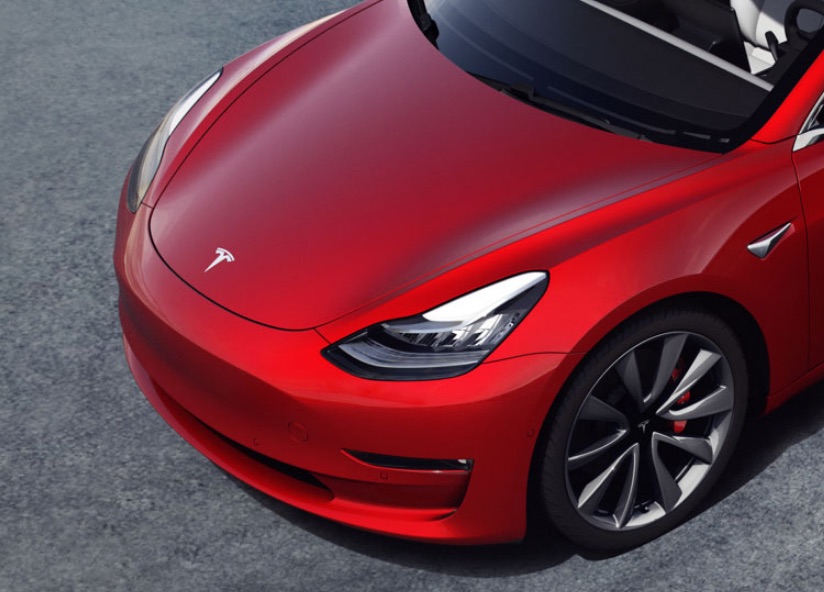
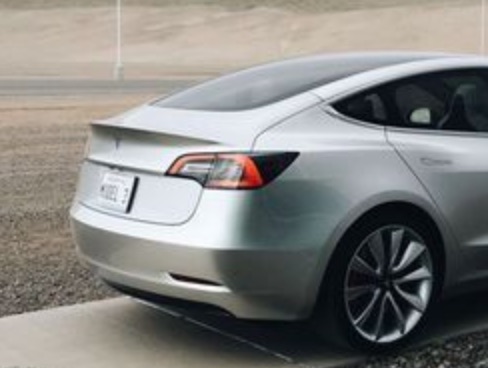 Left image
from Tesla.com
Left image
from Tesla.com.
Right from
https://finance.yahoo.com/
Tesla 3
has a "T" on the fronk lid, and, on the rear, a "T" above license plate
with no badging. However, some will have
a "Dual Motor" on right rear. Underline is "P" Performance.
I have seen
after-market "Model 3" and the "T" even on non-Tesla cars.
Tesla
Press Kit (not limited to reporters)
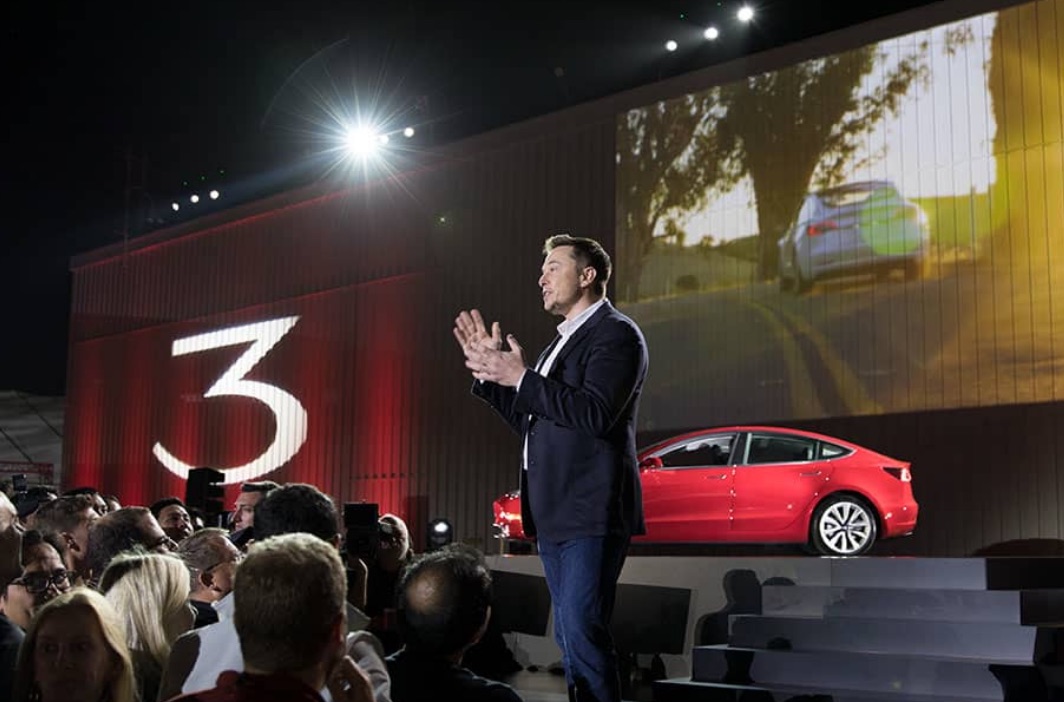 There are
2 videos of Elon Musk, one Introducing the Tesla 3 and a second one
where he
gives the history of Tesla Electric Vehicles.
There are
2 videos of Elon Musk, one Introducing the Tesla 3 and a second one
where he
gives the history of Tesla Electric Vehicles.
At this site, search for
"full presentation" and you will go to the 2 videos. The
link: https://www.tesla.com/presskit

In the videos
above, Elon mention what was said about Electric Cars when he began,
above.

Yet, by the
time the S, X, and 3 were out things changed.
How did Tesla get so
popular, and it is the only fully-electric that can go on extended road
trips
By
Brad TempletonSenior Contributor, Transportation, Forbes
Tesla built
its superchargers at great expense (and gave free unlimited use
to early Tesla buyers) because they wanted everybody to feel that Tesla
was the only car you could road trip in. They had reasons to not let
other cars use their chargers even if the plug was the same. Tesla also
spent a fair bit of money giving
Level 2 chargers with Tesla plugs to
hotels around the world to encourage Tesla drivers to stay at
their
hotels. The hotels pay for the electricity, and want to serve guests in
any kind of car, but Tesla didn’t give them free gear for that. Even
so, Elon Musk has said the Tesla charging network does not need to be a
walled garden. An adapter is available to let non-Tesla cars charge at
the Tesla level 2 chargers.
Brad TempletonSenior
Contributor
Transportation, Forbes
The average car is driven only 40
miles/day. The Level One charger
(which usually comes with almost any electric car) plugs into a
dedicated standard house plug, and can deliver 12 amps. This means it
will deliver 40 miles in an 8-hour overnight charging session.
Get the 20 amp plug (which Tesla sells and some other chargers sell)
and you will see 50 miles or more in an 8 hour night. The “T”
slot in it that says it is 20 amp.
A small battery car absolutely needs to get to full every night. The
large battery Teslas don’t.
Level 2
A Level Two circuit runs at twice the voltage and usually at higher
current. In fact, you can install these up to 80 amps.
20% to 80% full. On a 250 mile Tesla Model 3, you can get that in 8
hours with just 5 kw, which is what you get from a 30 amp plug, the
same one that runs your dryer. (On any plug, the car charges at 80% of
full current, in this case at 24 amps.) Such a circuit is going to
fully restore you on almost any day you drive, particularly if you have
more than 8 hours at home.
Sharing with your dryer or
unused elec. dryer outlet
Most houses have a 30 amp electric plug for your dryer. It may be easy
for you to switch to a natural gas dryer, particularly if you are in
the mood for a new dryer. They cost only a little more, but they cost a
fair bit less to run, and as such they save money in the long run. They
also cost the same day and night. You do need to get a natural gas line
at your laundry room. Adding that can cost real money — or be cheap —
depending on how far it has to come. Perhaps you can even sell your
electric dryer to somebody on Craigslist.
If you do this, you remove 30 amps of load from your house, and now you
can add a 30 amp line for your car without needing a service upgrade.
Your electrician can also in some cases just run a line from where your
electric dryer plug is (was) to where your car is. This is more than
enough power for your needs, and even though a new gas dryer is not
free, it can be the cheapest option of all.
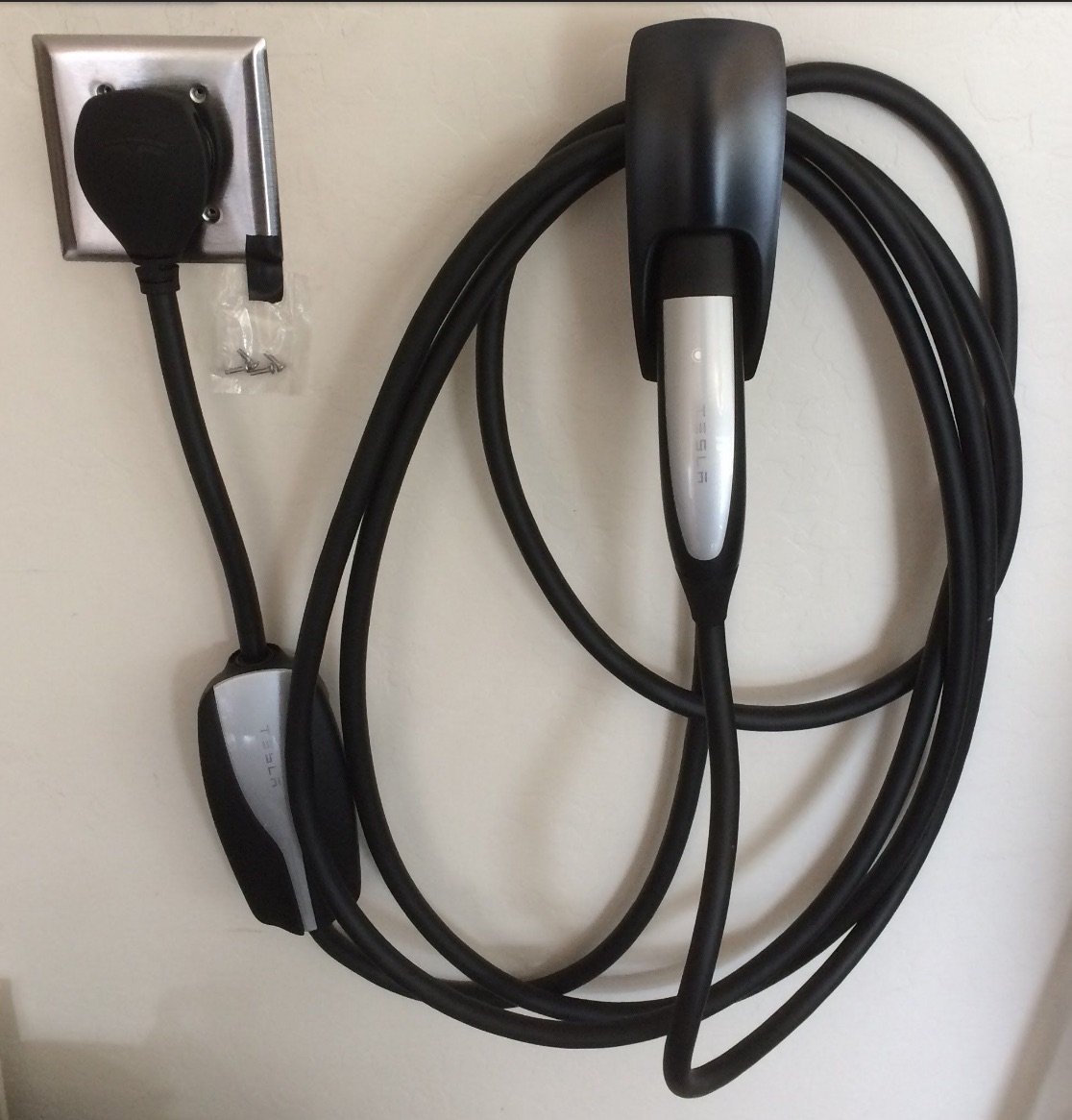
Model 3 Specs
Standard Range Plus-Rear Wheel Drive
Battery:
Standard
Range Plus
Acceleration:
5.3s 0-60
mph
Range:
250 miles
Drive:
Rear-Wheel
Drive
Seating:
5 Adults
Wheels:
19"
Weight:
3,552 lbs
Cargo;
15 cu ft
Displays:
15" Center
Touchscreen
Supercharging
Max/Payment Type
250 kW max; Pay Per
Use
Onboard Charger Max
11.5 kW max (48A)
Warranty
Basic Vehicle - 4
years or 50,000 mi, whichever comes first
Battery
& Drive Unit - 8 years or 100,000 mi, whichever comes first
STANDARD PLUS
Partial Premium Interior
12-way power adjustable heated front seats
Premium seat material and trim
Upgraded audio – immersive sound
Premium Connectivity (30 days included)
Tinted glass roof with ultraviolet and infrared protection
Power folding, heated side mirrors
Music and media over Bluetooth®
Custom driver profiles
Center console with storage, 4 USB ports and docking for 2 smartphones

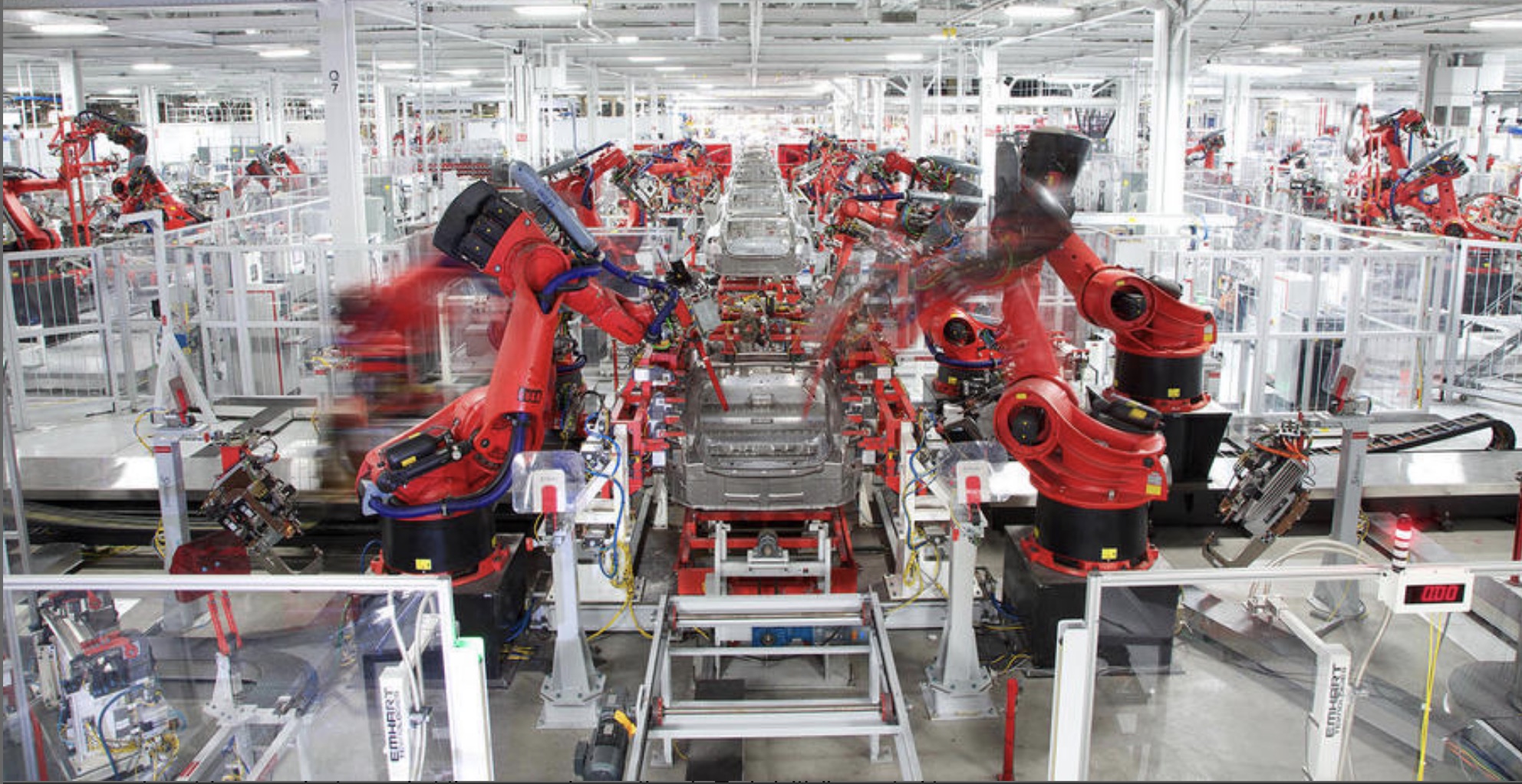 Being
built by robots has a certain mystique.
Being
built by robots has a certain mystique.
Excellent
site for shopping and comparing:
Cars
Incentives
Charging
Events
Dealers by ZIP Code: https://plugstar.zappyride.com/
Facts about charging a 2020 Tesla 3 Standard Range Plus:
https://plugstar.zappyride.com/cars/Tesla_Model_3_Standard_Range_Plus_BEV_2020?zip=92870
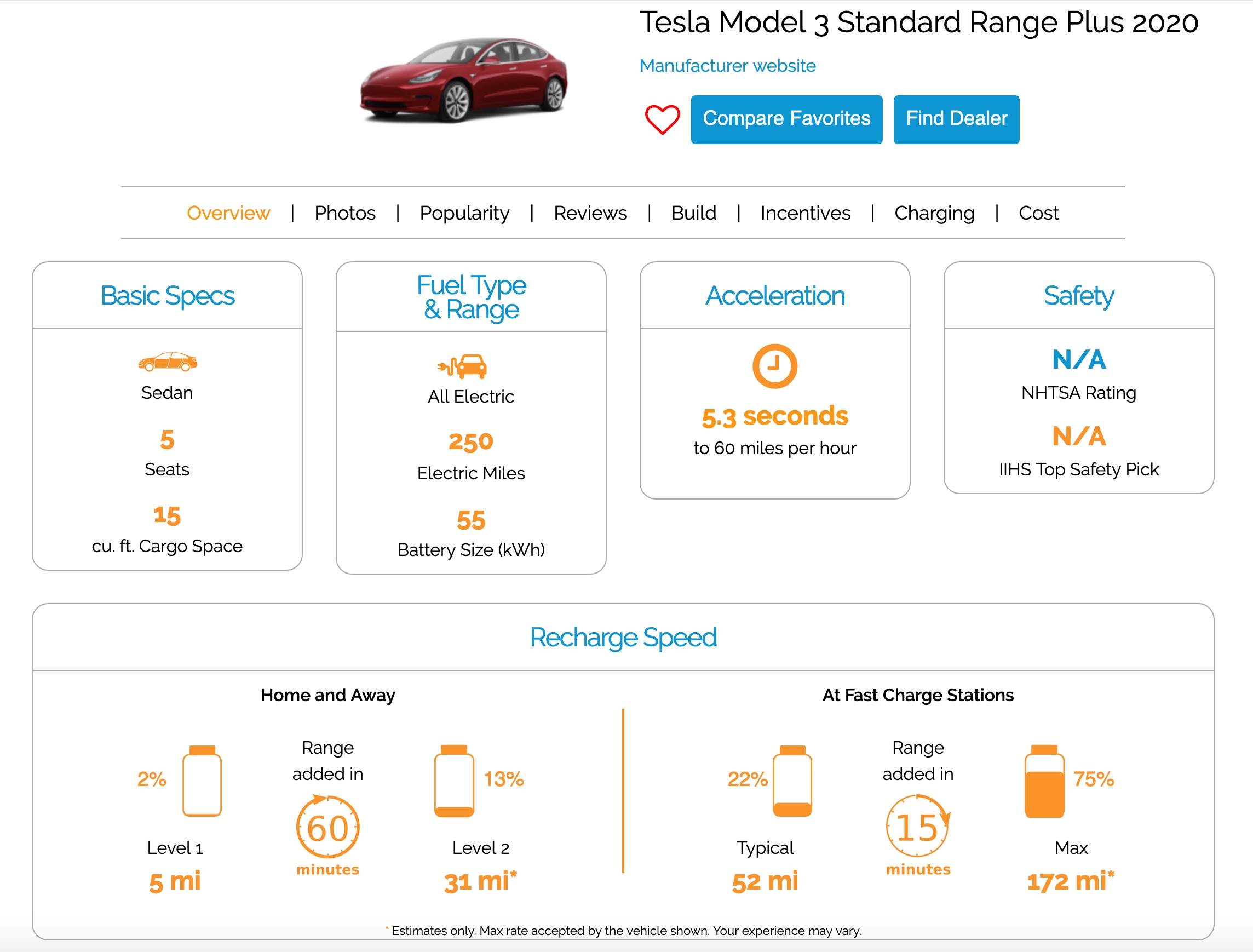
SAFETY (left out of above graphic) from Tesla's website for Model 3:
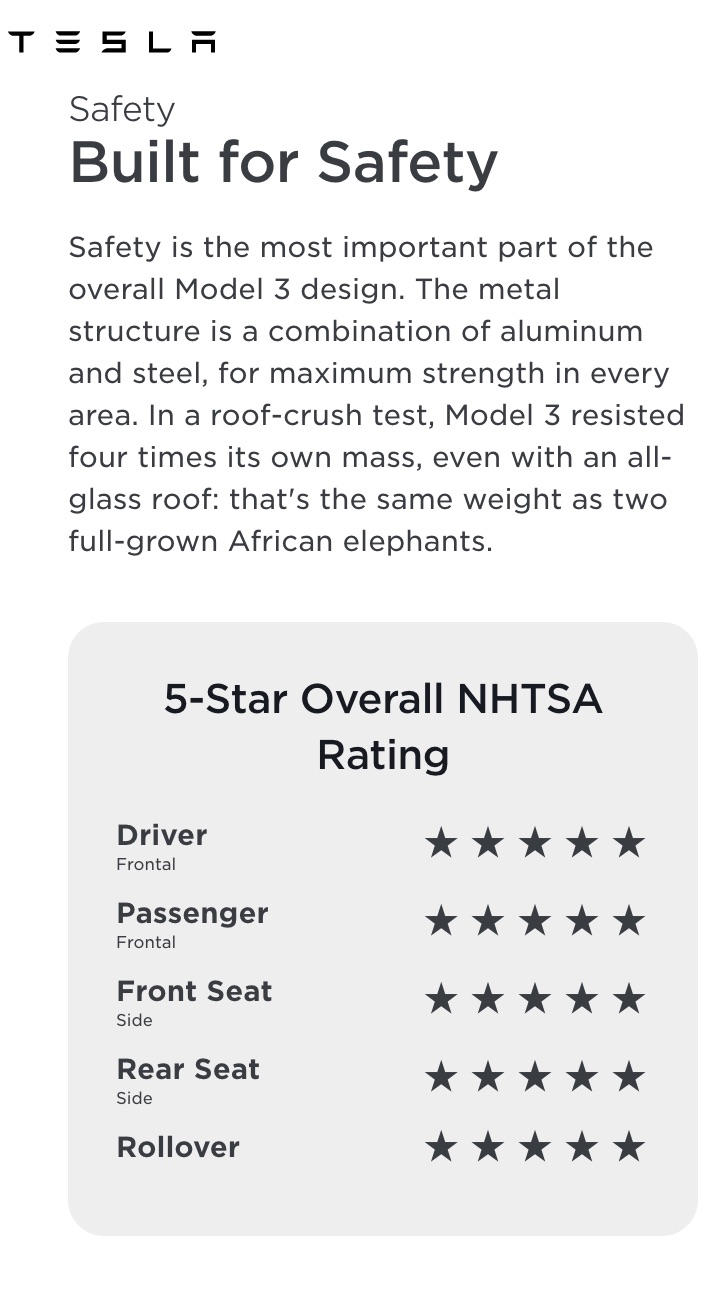 Click
above for larger image.
Click
above for larger image.
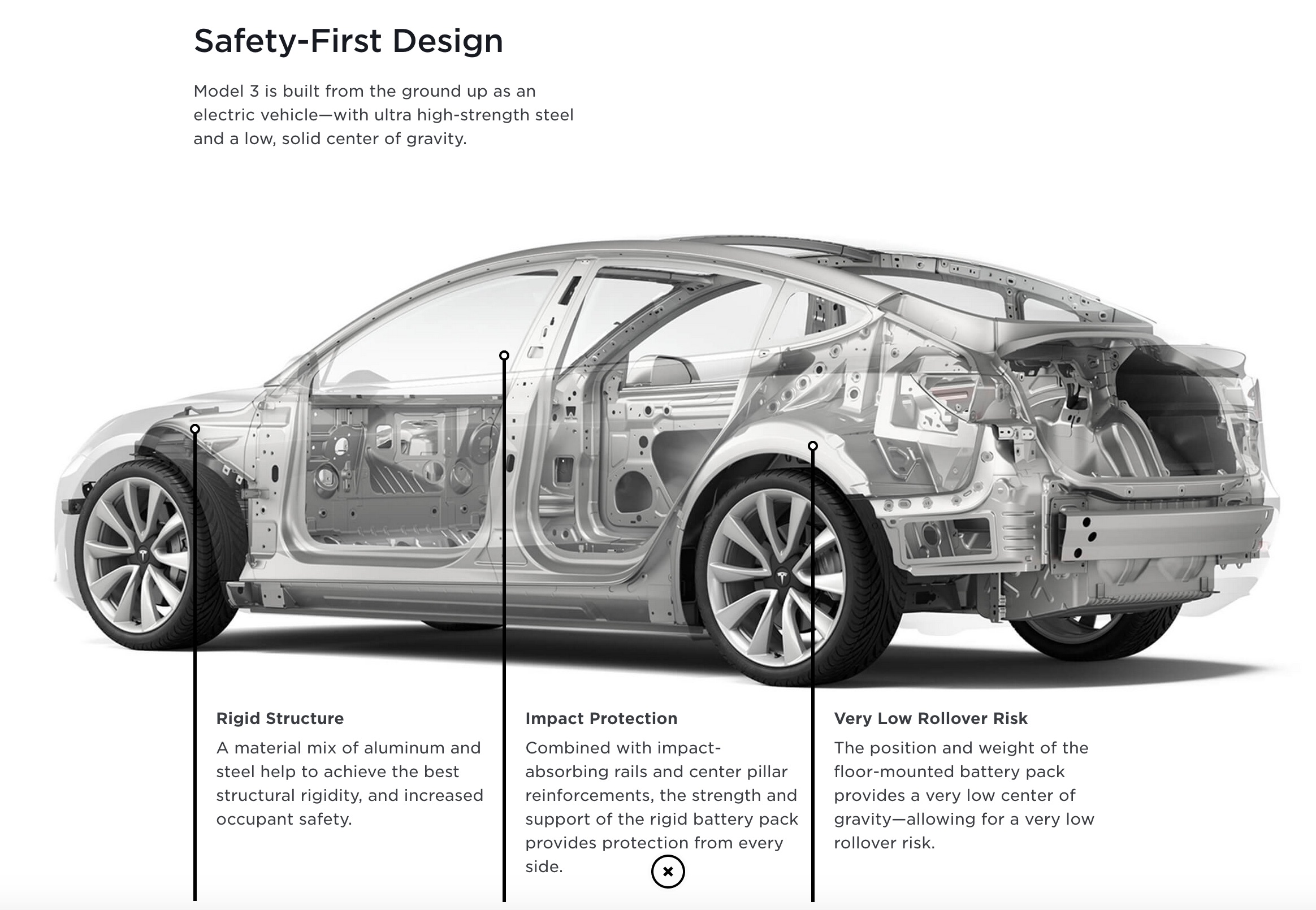
From: Tesla.com Safety
Plan Ahead on Energy Creation and Use
Solar is the best decision I made for our Southern California
single-family unit home. Late 2010, I purchased the Solar Plan
from AMECO. It included 16 solar panels and the converter, and
extra electrical panel to insure that I had the capacity to "charge an
electric car." At that time I was paying a monthly average
electric bill of $153. I now (June 2020) pay $20.73 a
month. Our best nighttime rate (10 pm to 8 am) is $0.15
per kwh (Delivery and Generartion Charges). Southern California
Edison has a system called Net
Metering
which is the amount of excess electricity exported to the grid by our
system. Finally, to reduce electricity usage, we converted from an electric dryer to gas dryer,
ultimately allowing me to use that 30 amp 240v plug to charge the Tesla.
My Plan to buy a Tesla
Three things that had to happen for us to afford a Tesla:
1) The Model 3 had
to become available other than Premium
cars.
2) I wanted to pay off our newest car (Which happened Aug.
2019) thus saving that car payment.
3) I had to sell our 1956 Chevy
210 Delray which
we had purchased in 1998. (That happened May, 2020)
Incidentally, I made $524.55 a year on that Chevy, making a nice down
payment of over 1/2 of the cost of this Tesla. This left a
monthly payment about the same on the resulting loan as what I was paying on the
van I
paid off.
4) Oh, with the classic Chevy, we had 3
cars for 2 people, so I sold our oldest car for $1,250 that Tesla had
offered us $400 as a trade in.
Sometimes you get lucky
After 3 years, the above 4 things finally happened and we made our
purchase order May 17, 2020 for a Tesla 3, Standard Range Plus
Rear-Wheel Drive. At the end of May, Tesla dropped the price on the Model 3s $2,000.
I wondered if I would get the $2,000 off since it was already on order,
so I asked the person Tesla assigned to me. She "put in a request" and
June 1, I got confirmation of a reduced price of $2,000! Plus,
Southern California Edison gives a $1,000 rebate for a homeowner who
has an electric vehicle. It can be applied for after I receive
the registration in the mail.
Notes from the Owner's Manual:
Preserving the Battery
Owner's Manual quote: The most
important way to preserve the Battery is to LEAVE YOUR VEHICLE PLUGGED IN
when you are not using it. This is particularly important if you are
not planning to drive Model 3 for several weeks. When plugged in, Model
3 wakes up when needed to automatically maintain a charge level that
maximizes the lifetime of the Battery.
Contacting Tesla for towing, etc.
Regional Phone Number(s)
Mexico: 1-800-228-8145
United States and Canada: 1-877-79TESLA (1-877-798-3752)
Note: The phone number is also available by touching the Tesla "T" at
the top center of the touchscreen.
I have been watching You Tube Tesla videographers for 3
years and have found these to be professional and informative:
"Now You Know" by
Zak and Jesse Cataldo,
who live in
Connecticut
"Tesla3Man"
who lives
in North Vancouver, Canada.
"Out of
Spec Motoring" especially the reports by Kyle, who lives in North
Carolina.
"Frugal Tesla Guy".
All four talk about
snow, sleet, and rain, none of which we get much of in Southern
California.
From Tesla3Man I learned this:
Best Charging Practices
Tesla3man. https://www.youtube.com/watch?v=TY2GDtJncG4
To make the battery last longer in day
to day use
1.
Accelerate Gradually
2.
Use the Energy App to incentivize yourself. Use consumption graph
and try to get more miles left at the end of the trip than they predict
on the car’s computer.
3.
Regenerative Braking – the more the better
4.
Limit top speed
5.
Lose unnecessary weight
6.
Tire inflation matters…keep at between 42 and 45 PSI check on
screen
7.
Keep your car clean and shiny (Slip through the air easily, with
lowered resistance)
8.
Choose a route with fewer stops (stop lights or signs). Less startup
saving battery.
9.
Keep windows up causing less buffeting, wind resistance (heating does
take energy) Use seat heaters rather than cabin heater, wear a jacket
10.
Get car hot or cool before you begin the trip while plugged in. (Insert
departure time.)
Best Charging Practices by Tesla3man
https://www.youtube.com/watch?v=sNsCNzsq1mo
1.
Avoid the extremes (high or low SOC [State of Charge]) Don’t go to 1%
and if you charge to 100%, do it and leave on trip right away.
2.
Precondition the battery while on the road to Supercharger so it gets
itself in the best state for charging.
3.
Cold weather – preheat while connected to power in freezing conditions.
On phone 30 minutes before leaving, press defrost on phone to warm up
the cabin.
4.
Etiquette at Supercharger location Don’t jump the line.
Don’t use second charger of a pair, not in 2a if someone is at 2b.
5.
Arrive with the lowest % of charge for a faster charging experience.
6.
If it is extremely hot, wait until a cooler time of day. Charging is
slow and car A/C will start.
7.
Charging for a Road Trip. Use charging “Departure” time.
8.
Regular charging practice. 75% - 80% for local driving.
Leave it plugged in. Battery performs best when charged regularly.
9.
Weird noises during charging? Relax – it’s normal.
Refrigerant and fan engage if battery is hot. It prioritizes
cooling battery over cooling occupants of the cabin.
10.
Adjust the home charge current if other devices share the charge
circuit. (I don’t share)
11.
Slow home charging is better for battery life than Frequent Fast
Supercharging.
12.
At Supercharger: Unplug as soon as charging is complete..or you
could get charged by Tesla. (To avoid "idle" charge fees.). When you
get on your phone: "Charging is almost complete"…unplug and move
to a non-charging spot..
My Referral Number is https://ts.la/carl41979 Just click
the URL to the left to go to the Tesla.com site that will explain the
benefits of using a referral number:
Next, Receiving the VIN and Delivery Date.
.







